CONSTELLATION GUIDE
Last updated: 28 April 2001
CONSTELLATION GUIDE |
"GO TO"....OPHIUCHUS
(with discussions of objects in Serpens)
Slithering With "The Serpent Handler" With Your ETX and LX 90 Telescope
From: sherrodc@ipa.net (Clay Sherrod)
ABOUT THE CONSTELLATION "GO-TO" GUIDES!
In this FOURTH constellation guide installment, "GO TO OPHIUCHUS"- of our constellation study guides for ETX and LX 90 telescope users - we will explore a fabulous selection of fine globular clusters, and our first "dark nebula" of the deep sky. As will all of our "GO TO GUIDES", it features a "start" with an easy GO TO to the bright star RAS ALGHAGUE, and then proceeds through the many WONDERFUL globular clusters and interesting objects within reach of YOUR telescope! This fourth Guide encompasses both Ophiuchus and the "snakes" of our night skies....SERPENS CAPUT and SERPENS CAUDA, to the west and east, respectively, of Ophiuchus. From bright starry globular clusters to beautifully-colored and complex multiple star systems, discussions along the way tell you what to expect from each telescope size and type. All objects will be discussed with exact descriptions of what the viewers of the ETX 60/70, ETX 90, ETX 125, and LX 90 should expect to see...and what to NOT expect to see!
As in all Guides, useful magnifications for EACH GO TO object are discussed for certain telescopes, what type of night and conditions are needed to see certain details, double stars that can be resolved in each telescope model, and much, much more. It is your complete GUIDE for your deep sky observing pleasure and a very handy tool for use at your next star party!
Needless to say, it WILL put your AutoStar to work for you in a most efficient and enjoyable way!
I hope you will enjoy these comprehensive GUIDES to "Touring the Constellations" which will feature a NEW constellation about every two weeks, complete with diagrams, charts and illustrations. Please let us hear from you with summations of YOUR observations through these constellation tours!
----------------------------------
Introduction -
Ophiuchus (pronounced "O-fee-ew-cus") is one of the largest of all constellations and dominates the seemingly bright-star void skies of mid spring at late night. The mighty "Serpent Handler" of our skies would not be complete without his two accompanying "snakes,", Serpens Caput (to the west of Ophiuchus) and to its east, Serpens Cauda.
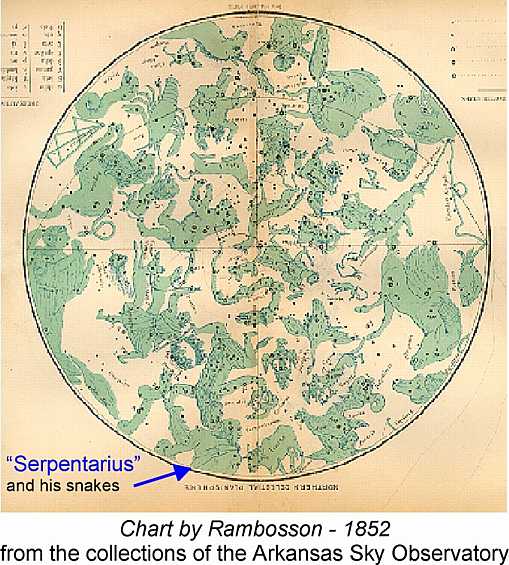
Ophiuchus once took up much more of the starry sky than it does today, but for thousands of years has been known as a "snake charmer," serpent handler, or the "snake man" to ancient cultures. Although the early Greek philosophers clearly recognized him through the Arabic origins, it is interesting to note in the very early and picturesque French planisphere shown above that the constellation is referred to as "Serpentarius", albeit a rose with a different name.....is still a serpent handler.
The click-on chart shown below can be downloaded to a file on your computer, resized in that file and printed as a complete star reference chart for these four constellations. Each of the reference numbers apply to the concise listing of objects found following.
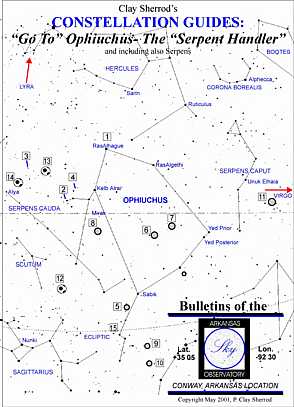
Perhaps my readers will have a bit easier time than do I realizing a depiction of a "snake handler" among this widely scattered star group. Note that our celestial equator ("0" degrees declination) passes through the southern part of this huge constellation and that the ecliptic (the "zone of animals" in which the sun, moon and planets appear to progress) is arced to the south of this springtime constellation.
If you can visualize Ophiuchus as a person handling snakes, then you surely can make out the two snakes that he has in his hands, Serpens Caput grasped tightly in his left (west) hand and another seized serpent held firmly in his right hand, Serpens Cauda.
It is among these three constellations that many of the finest globular clusters visible from Earth are found, as well as very rich star clouds of the Milky Way in eastern Ophiuchus and Serpens Cauda. This is an area so rich in star clouds, nebulosity, and dark nebula that everyone should take time out away from their high-powered and limited, narrow field telescopes and scan these constellations slowly with a good pair of binoculars on a very dark sky away from city lights. It is truly a spectacular sight in the eastern realm of the constellations.....we are approaching the center of our own Milky Way galaxy as we progress eastward toward Sagittarius.
Although often overlooked because of the impending arrival of the brighter Lyra, Aquila and Cygnus constellations of late night spring or summertime, this area of sky is very rich in galaxies, clusters, dark obscuring dust (one such item is included in the GO TO list that follows), and many wonderful double stars that are both optically appealing and challenging to test the precision and alignment of your telescopes as well.
----------------------------------
YOUR OPHIUCHUS / SERPENS CONCISE DIRECTORY
There are 15 objects15 objects in this constellation GO TO tour; all are in reach of every telescope in our "ETX and LX family" yet each telescope will demonstrate uniquely different and challenging aspects of the objects. In addition to the 15 finest objects, there are literally hundreds of wonderful double stars that are visible in most of the ETX and LX scopes as well as many fainter globular clusters (check your AutoStar library for "ngc" listings!), stars of curious colors and motion. It is in this general area, the constellation of OPHIUCHUS that offers our best vantage point for observing the absolutely incredible selection of beautiful globular clusters.
As will all of our GO TO TOUR GUIDES, I continue to recommend good a good star atlas and/or chart which lists the finest objects constellation-by-constellation; if you cannot access any of these objects (or those that are not listed in this TOUR), you can access directly from coordinates - Right Ascension (RA) and Declination (DEC) of any known object via the AutoStar. You merely need to hold down your MODE key on the AutoStar for three (3) seconds and the RA and DEC coordinates appear for the telescope. Merely press "GO TO" and the cursor appears prompting you to enter the Right Ascension of the object if it is NOT listed among the objects in the AutoStar library; once the RA is entered, press "Enter" and the cursor once again prompts for the Declination coordinates (these coordinates for epoch 2000) are found in all good observing guides). Once those are entered, merely press "GO TO" once again and your ETX or LX 90 will slew to the position of the object!
The following constellation guide to objects at the end of this TOUR will describe all the details of each object and provide specifics as to visibility of that object in YOUR telescope model.
The constellation tour star chart here (click on and print to size, above) will get you started, as it demonstrates the relative positions of all objects in this "tour" to the conspicuous stars outlining the distinct figures of our three constellations of this TOUR.
Following is the complete 15-object list for your "GO TO TOUR" of Ophiuchus and Serpens; you may wish to find the majority of the objects from the AutoStar library (for example, you can merely pull up Messiers 9 or 12 by going to "Object/Deep Sky/Messier Object/M-9....enter....GO TO" or...if you want to experiment and be a "better AutoStar user", try entering the following coordinates (provided in the list directly following) as described under MODE above.
OBJECT 1:
bright star - Ras Alhague (alpha Ophiuchii) - R.A. 17h 33' / DEC + 12 36 - Magnitude: 2.1
OBJECT 2:
tough double star - 70 Ophiuchii - R.A. 18h 03' / DEC + 02 03 - Magnitudes: 4.2 & 5.9
OBJECT 3:
good variable star - X Ophiuchii - R.A. 18h 36' / DEC + 08 47 - Magnitude range: 6 to 9, 334 days
OBJECT 4:
Barnard's Star! - "the runaway star" - R.A. 17h 55' / DEC + 04 24 - Magnitude: 9.5 (chart attached)
OBJECT 5:
a globular cluster - Messier 9 (ngc6333) - R.A. 17h 16' / -18 28 - Magnitude: 9.0
OBJECT 6:
globular cluster - Messier 10 (ngc6254) - R.A. 16h 55' / DEC -0402 - Magnitude: 7.9
OBJECT 7:
globular cluster - Messier 12 (ngc6218) - R.A. 16h 45' / DEC -01 52 - Magnitude: 8.0
OBJECTS 8:
globular cluster - Messier 14 (ngc6402) - R.A. 17h 35' / DEC -03 13 - Magnitude: 9.5
OBJECT 9:
globular cluster - Messier 19 (ngc6273) - R.A. 17h 00' / DEC -26 11 - Magnitude: 8.1 (nice object)
OBJECT 10: (actually in Scorpius)
bright globular - Messier 62 (ngc6266) - R.A. 16h 58' / DEC -30 03 - Magnitude: 6.6 (very nice globular)
OBJECTS 11: (Serpens caput)
best globular! - Messier 5 (ngc5904) - R.A. 15h 16' / DEC + 02 16 - Magnitude: 6.2 (the very best of all!)
OBJECT 12: (Serpens cauda)
diffuse nebular and star cluster - Messier 16 (ngc6611) - R.A. 18h 16' / DEC -13 48 - Mag.: 8.3
OBJECT 13: (Ophiuchus)
large open cluster - IC 6633 - R.A. 18h 25' / DEC + 06 32 - about 20' arc across, very nice, 65 stars
OBJECT 14: (Serpens cauda)
galactic cluster - IC 4756 - R.A. 18h 37' / DEC + 05 26 - Bright (m = 5.1) with lots of stars at low x
OBJECT 15: (Ophiuchus)
dark nebula! the best! - B72 (Barnard's nebula) - R.A. 17h 21' / DEC -23 35 - Very interesting, S-shaped
--------------------------------------------
A VISUAL GUIDE TO OUR OBJECTS IN THIS CONSTELLATION SELECTION -
Object 1 - Bright Star RAS ALHAGUE (Alpha Ophiuchii)
From the Arabic, this magnitude 2.1 star denotes the "head of the serpent-charmer," and we can well imagine from this middle-Eastern origin the mighty King Cobra as it is wooed by the skills and undaunting courage of the mystical "serpentarius." It is likely that Ras Alhague is tied with the seven brighter members of the Ursa Major "association" which all appear to comprise a very loose yet close star group some 70 light years distant. Now that you are locked onto the brightest star in this seemingly star-poor region of our sky, we will begin our GO TO tour.
Object 2 - Very beautiful double star 70 Ophiuchi
This double star - at a separation of 2.0" arc has two stars of very nice color contrast. It is unmistakable at higher magnifications, but does require at least the ETX 90 on the very best nights. About 200x should split these two 4.2 and 5.9 stars with just a thread of darkness between in that scope. It is an outstanding sight in my ETX 125 at 227x, with the fainter of the two stars very, very red and the brighter component a vivid deep yellow; this is one of my all-time favorite color-contrasting doubles. Look for the fainter companion star almost exactly due west of the brighter, yellow star. At a distance of only 60 light years, this star system's odd "wobbling" in space suggests that it is likely orbited by a dark object, perhaps a large planet, that is some 10 times the mass of our own Jupiter.
Object 3 - Variable Star X Ophiuchi....good for all scopes, low power and even binoculars!
Varying from magnitude 6 to 9 at a period of just less than one year (334 days), X Ophiuchi really is a great "beginning" variable star and is ideal for the ETX 60 and 70 with their wide fields of view. The chart link listed below will take you directly to a chart from the American Association of Variable Star Observers (AAVSO) in Massachusetts. Merely right click on the chart and "Save as..." into a folder. RE-SIZE and print and you have a wonderful year's work ahead of you!
simple click onto this direct AAVSO link: http://charts.aavso.org/OPH/X_OPH/XOPH-A.GIF
Note that this is an ETX- and LX- "user friendly" chart in that the field has north at the top and east at right, just the correct orientation for catadioptic telescopes with the right angle mirror or prism in use.
Note the slow and very predictable nature of the light changes in X Ophiuchi as shown in the following light curve derived from about two of the 334-day cycles of this interesting low power variable star:
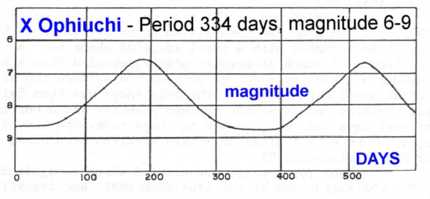
Object 4 - BARNARD'S "RUNAWAY" STAR
At first glance this would be a very faint, uninteresting star. At 9th magnitude, the star is visible in all of our scopes, although a bit more difficultly in the ETX 60 and 70 unless you use the star chart provided below. This is a tiny little star, with a total diameter of only ONE-HALF the distance between the Earth and Moon! (140,000 miles across) By comparison, our own sun has a diameter of over 800,000 miles.
"Barnard's Runaway Star" has the distinction of have the largest PROPER MOTION (its apparent movement across our skies as we see it relative to more distant stars behind it) of any other star in the Milky Way. It is a magnitude 9.5 red dwarf star (yes, its reddish color CAN be seen in the ETX 125 and larger scopes) and moves nearly due north EACH YEAR by an incredible 12" arc - that is about 1/4 the diameter of the planet Jupiter. As can be see from the figure below, this rapid motion can actually be plotted year-to-year.
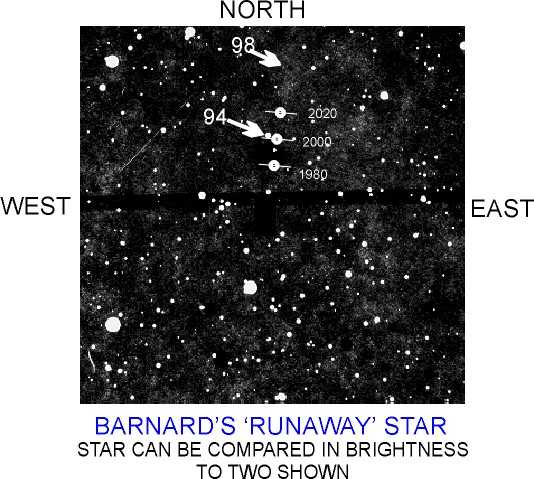
Part of its rapid apparent movement that we see is from the fact that Barnard's Runaway is ONLY 6.0 light years away; it also is physically moving very fast as well. In the accompanying chart, the orientation is REVERSED, in that it matches the field as seen through our telescopes with a right angle prism or mirror, with NORTH at the top and EAST to the right. There are two stars in this chart that I have marked with arrows and numbers, the numbers (decimal points omitted so you won't confuse them for little stars!) are the actual magnitudes of these indicated stars; note that Barnard's Runaway is VERY close in magnitude to each of these stars. At the present time, the star makes a very interesting "optical double" with the fixed star nearby!
Object 5 - One of Many Globular Clusters! Messier 9
The ninth object cataloged by eighteenth century comet hunter Charles Messier, this is one fine example of the many globular star clusters found in the constellation of Ophiuchus and surrounding areas. For a full in-depth discussion about the globulars and WHY so many of them seem to be concentrated in this general direction, read my Observing Guide: OBSERVING GLOBULAR CLUSTERS, found at:
http://www.weasner.com/etx/ref_guides/globulars.html
Be sure and observe ALL the globular clusters on this segment of your constellation TOUR and come back to Messier 9 for comparison! You will immediately realize that this one globular is by far SMALLER and more compact that all the rest! In addition, this globular is more of a crucial test for our telescope size ranges; the ETX 90 will not resolve the stars in this globular, but will partially resolve the others on the list. Peripheral stars, a few, can be clearly seen in the ETX 125, and the LX 90 begins to break down a few stars toward the center core of this cluster. At a faint magnitude 9.0, it is not at all resolvable in the ETX 60/70, appearing like a bright and very small round "ball" of cotton at medium power.
In your larger two telescopes, particularly the 8", look for two ADDITIONAL CLUSTERS (both very distant globulars that WILL NOT be resolved), the first NGC 6342 (1.5 degree southeast - use a very low power wide field eyepiece to find it and then go up to about 120X to view) and then NGC 6356 some 1.2 degrees northeast of M-9. The figure below shows Messier 9 (oriented correctly for the ETX / LX scopes) as it would appear visually in the ETX 125. Photo courtesy Lowell Observatory archives.
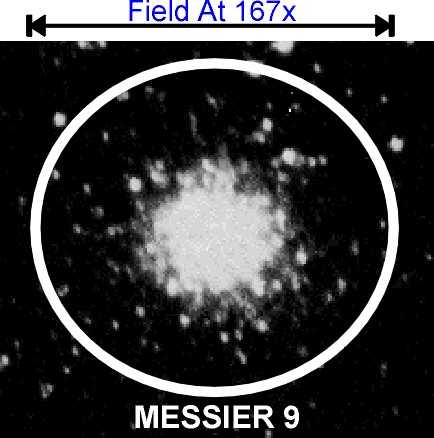
Object 6 - Globular Cluster Messier 10
This is a far better sight in our telescopes than the difficult Messier 9 (above). At magnitude 7.0, this is one of the brightest globulars and presents a wider "scattering" of stars. Unlike the tightly-packed M-9, Messier 10 has its stars spread widely across the field (see figure below, courtesy Lowell Observatory archives), easily resolvable in the ETX 125 telescope; at medium power SOME stars around the very edges may be glimpsed with the ETX 70 as well; the LX 90 at 160x and above will show about 70 stars with a very pronounced concentration of brightness right in the center. Look for this central brightening as well with both the ETX 90 and ETX 125.
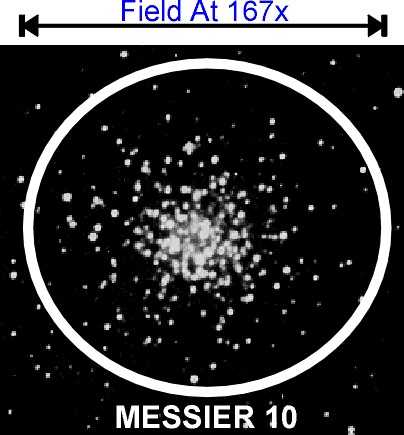
Object 7 - And yet, another Globular Star Cluster! Messier 12
Forming a very nice pair of "faint fuzzies" in the 8 x 50 finderscope of the LX 90 and easily in the same lowest power field of views of the ETX 60 and 70, Messier 12 is only a bit more than 3 degrees northwest of Messier 10. Like Messier 10, M-12 is VERY loose for a globular cluster, almost appearing as a tight open galactic cluster. The star resolution is relatively easy with the ETX 125 at about 150x and many peripheral stars can be glimpsed on a very dark night with the ETX 90 at around 120x. The LX 90 shows good star images all the way to the center of this object. The very scattering of stars loosely is perhaps attributable to its easy resolution in nearly all of our telescopes. Look for "clumps" of stars, places where many stars appear to be more closely grouped, throughout M-12 in the ETX 90 and larger telescopes. Some of these "tight" areas can be clearly identified in the photograph below (courtesy Lowell Observatory archives) which has been digitally altered to provide a view that might be expected with the LX 90 at medium-high magnification.
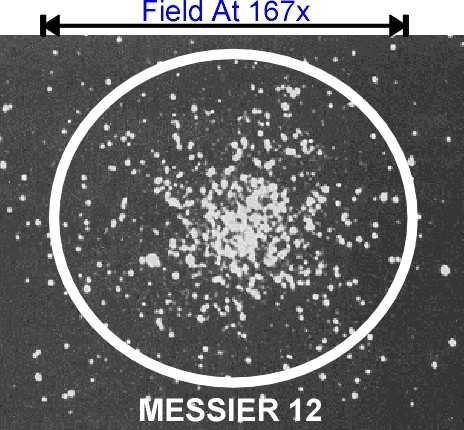
Object 8 - Messier 14 - Can it BE? YES! It's another globular cluster!
I told you that Ophiuchus offered a plethora of globular clusters (if only we knew what exactly a "plethora" comprised). Messier 14 is one of the richest of the springtime globulars, conveniently placed in a part of this constellations where there is little else of interest! This is NOT a bright globular and do not expect to see any star resolution in the ETX 90 and smaller telescopes. It is VERY tightly packed with a total magnitude of about 9.2 visually, and tiny stars of magnitude 15 to 16 mostly. Because of its packed nature, event the 8" cannot "see" the central structure of this globular and ONLY the peripheral stars may be glimpsed under very dark conditions with both the ETX 125 and LX 90. On very, very dark sky sites, the larger scopes MAY be able to see "star streamers" than appear as strings emanating from the central part of this cluster. Two such streamers are clearly visible in the following photograph (courtesy Lowell Observatory archives) at DUE NORTH and at the lower left of the cluster. I have digitally altered this photograph to match both the orientation and the image as seen at about 227x with the LX 90 8" scope. Messier 14 is much more distant that M-10 and M-12 which are both "paired" gravitationally.....M-14 is an incredible 70,000 light years distant compared to only 24,000 for M-10 and M-12.
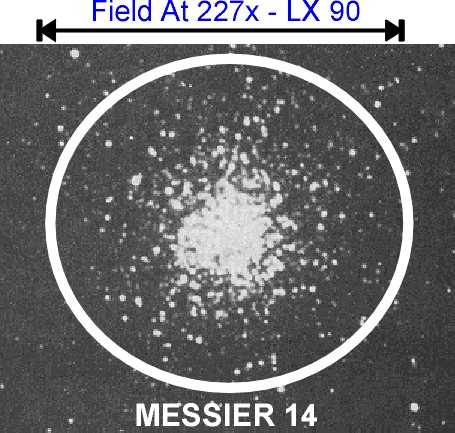
Object 9 - And....in case you haven't seen one yet.....a GLOBULAR CLUSTER! Messier 19
Although very, very small by comparison with the more spectacular Messier 5 and others, this is still a very fine globular for small and medium scopes. With individual stars of magnitudes 14th and below, it is not too difficult to begin to realize some resolution with the ETX 125 and LX 90. However, the true beauty of observing this globular may not be the cluster itself. In the ETX 60 and 70 and all scopes with very low power and wide fields, this provides one of the most striking of all celestial sights, in a very, very rich star field of the fringes of the Milky Way. The cluster in wide field views appears suspended almost 3-D amidst many beautiful stars. As the photo below shows (courtesy Lowell Observatory archives), the cluster is distinctly oblong, or elliptical; the photo has been digitally altered to match the orientation of your ETX or LX scope and to appear as it might in the LX 90; the ETX 125 actually provides a VERY similar view! This cluster is a very few thousand (but who's counting anyway) light years further than M-10 and M-12, so it is apparently a physically smaller object overall.
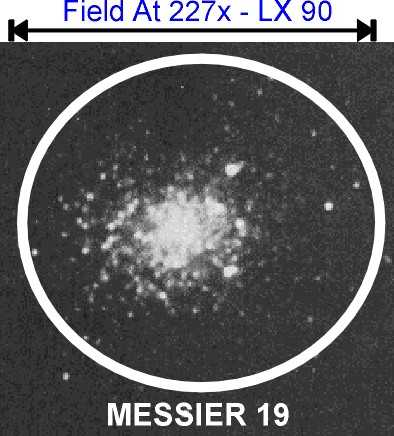
Object 10 - Messier 62 - Yep, another Globular....but this one's in Scorpius....and pretty nice!
Right on the Ophiuchus/Scorpius border, you will find one of the most spectacular and large of all the globular clusters. You MUST check this one out, even at low power. Very bright at the center and surrounded by a faint glow (fairly large) in the ETX 60 and 70, this cluster can be resolved around its edges with the ETX 90. In the ETX 125 there is an absolute blaze of faint stars seen in the very center of this fine object; the view in the LX 90 is breathtaking. After you have taken in this spectacular view at medium-high (about 30x per inch aperture) drop the power down in your telescope and just sit back to look at this fantastic sight with the widest field eyepiece you have. Messier 62 is located amidst one of the richest star fields of the Milky Way, and the view is stunning on a very dark night; M-62 stands out like a beacon among many thousands of stars visible in your scope in the same field. With the ETX 125 and LX 90 at very low magnification, it is an awe-inspiring sight, with the faint stars around the edge of M-62 glowing clearly and the bright cluster suspended in the starry field.
Object 11 - Guess what...
We have already explored this wonderful globular in the Constellation Guide installment on Bootes; Messier 5 is the granddaddy of the globulars, huge, bright and easily resolvable. It is a showpiece when you can take your telescope to the darkest site available. I have included this fine object (it is very close to all the others, so a GO TO should not be so difficult) so that you can use it as a reference for all the others you have just viewed. Messier 5 is truly remarkable and serves as a guide for the others you have explored. For a full discussion, please link to the Bootes Constellation Guide at:
http://www.weasner.com/etx/ref_guides/bootes.html
Object 12 - Messier 16 (Serpens) Nice Galactic Open Cluster with Nebula (what? no globular?)
The "Eagle Nebula" This is a wonderful object for a clear, very dark and moonless sky, often overlooked because of common suburban observing conditions. Messier 16 is a wonderfully rich large open cluster with some fantastic bright nebula surrounding it, but requires a very dark sky site to observe. This is one object where the ETX 60 and 70 will beat them all! Very low powers and wide field will reveal one of the most spectacular objects of the sky. It is a VERY rich star field, combining a vista of the Milky Way with a very nice galactic cluster and much bright nebulosity. The nebula is NOT conspicuous like the Orion nebula, but requires some real searching and very well dark-adapted eyes. Try moving the telescope slightly back and forth across the star cluster to get the full effect of the bright "glow." A good wide field and very dark skies are more important than aperture on this one, so use your lowest and most favorite wide-field eyepiece, regardless of which telescope you might have. There are about 100 stars in M-16, all of which can be seen in the ETX 125 and LX 90, about one-half of them in the ETX 90 and some 17 visible in the ETX 60/70. Medium powers on the larger two telescopes MIGHT reveal many intrusions of "dark nebula" inside the lighter diffuse nebula, cone-shaped protrusions that really enhance the appearance. The most obvious and interesting of all is the "Black Pillar" nebula in the SE part of this brighter cloud. When looking at this object, try to image its location....it is in the great Sagittarius Arm of our own spiral galaxy. You are looking across the vastness of space and yet another arm inside our own toward the center of the Milky Way at a great cloud of stars some 8,000 light years distant!
Object 13 - Galactic Cluster IC 6633 (In Ophiuchus)
A nice, often overlooked, galactic cluster. It is quite large (20' arc, almost 2/3 the size of the moon's disk!) and has a total magnitude of about 5.0, so it should be somewhat naked eye on a very dark night. It is an excellent object for the ETX 60 and 70 and nice with the three larger scopes with very wide angle eyepieces. Located in the star-rich fields of the nearby Milky Way, you can see about 65 stars in all scopes down to about magnitude 7. If this object were not so large, it undoubtedly would have made Messier's famous list of beautiful deep sky objects.
Object 14 - Another Open Galactic Cluster (in Serpens) - IC 4756
This is a must-see for the ETX 60 and 70 users; the rest with more narrow fields of view must rely on a good pair of 10 x 50 binoculars! This is a very large open cluster containing perhaps 80 stars down to magnitude 7 and 8....but it is big: the size of more than two full moons across! So obviously, a field of view of about 1.2 degree will be required, just perfect for the ETX 60 and 70; try the 40mm Plossls on the other scopes or perhaps one of the 32mm Super Wide eyepieces on the ETX 90 and 125; in the LX 90, you will only be able to get the entire cluster in with the 56mm Super Wide eyepiece....you might try the finderscope, which provides and outstanding view with all stars clearly distinguishable!
Object 15 - A Dark Nebula - "Barnard's Nebula" / B72
Well, Mr. Barnard had a star in this Guide and he also has a famous nebula....but not the bright kind. Barnard's Nebula is a very difficult (you must use averted vision where you scan around the object but never look directly at it) object, showing as a dark intrusion over a brighter star-filled field of sky. There are so many stars in this bright area of the Milky Way that it appears almost as a background "glow" in the sky on a very dark night. This dark cloud is overriding the bright stars behind it and is clearly "S" shaped, about 30' arc diameter, or about the size of the full moon's disk. Thus, you must use your 26mm eyepiece in the ETX 90 and 125 to get it all in, a 32mm or 40mm in the LX 90 and actually about a 15mm in the ETX 60 and 70 for best views. Find this cloud ONLY about 1.5 degree north-north-east of Theta Ophiuchi, which should make it very easy to find. What you should expect to see at very low wide field power is a place "....where stars aren't." In other words, in this area just FILLED with tiny star images, attempt to locate this spot by a conspicuous ABSENCE of stars just NNE of Theta Oph.
--------------------------------
WANDERING ABOUT....YOUR NEW "USER OBJECT" OPHIUCHUS
This brief GO TO Tour of Ophiuchus and Serpens has revealed a big chunk of our visible Milky Way Galaxy, many globulars and your first "dark nebula" and star of large proper motion. But please do not stop here. Go ahead and locate many of the hundreds of other ngc galaxies that are present in this constellation.....there are several more interesting double and multiple stars that are within the reach of your telescope. In addition, use this opportunity to actually TWO MORE (!!) USER OBJECTS onto your AutoStar!
LET'S LOAD THE UNCANNY FOR USER OBJECTS THIS TIME! Take your AutoStar and let's load up "Barnard's Runaway" star and ALSO "Barnard's Dark Nebula". These are highly unusual objects, and great for "astro conversations" so you could not find any more appropriate and interesting subjects to add to your growing "User Object" library.
On AutoStar, go to: "Select/Object [enter] and scroll down to "user object" [enter]. Now enter the coordinates listed above for both the "Runway Star" and then as ANOTHER object for "Barnard's Dark Nebula"; under "description" put in a nice title for these two so that it will pique your curiosity every time you see them as you scroll through your list.. You will now have as your FOURTH AND FIFTH TOUR USER OBJECTS two of the most unusual objects that you could possibly select!
Next Constellation "GO TO TOUR" Installment: HERCULES, its famous Messier 13 cluster (haven't had your fill of globular clusters yet??), as well as many fascinating multiple stars, some nice mythological lore and a few good deep sky objects
Good observing and explorations of the wonderful world of deep space!
P. Clay Sherrod
Arkansas Sky Observatory
Conway / Petit Jean Mountain
Arkansas
Return to the top of this page.
Go back to the Observational Guides & References page.
Go back to my ETX Home Page.